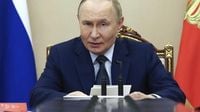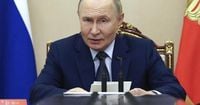On September 22, 2025, Russian President Vladimir Putin made a striking announcement that reverberated through diplomatic circles and security communities worldwide. Speaking from the Kremlin during a meeting with Russia’s Security Council, Putin declared that Moscow would continue to abide by the nuclear arms limits set by the New START treaty for one additional year after the pact’s scheduled expiration in February 2026. The move, he emphasized, was intended to preserve a fragile measure of global stability at a time of heightened geopolitical tension and uncertainty.
The New START treaty, signed in 2010 by then-U.S. President Barack Obama and Russian President Dmitry Medvedev, remains the last major arms control agreement standing between the United States and Russia. It strictly limits each nation to no more than 1,550 deployed nuclear warheads and 700 deployed missiles and bombers. These caps are designed to reduce the risk of a nuclear arms race and to provide mutual predictability in the world’s two largest nuclear arsenals. The treaty also includes provisions for sweeping on-site inspections to verify compliance—though, as numerous outlets including Associated Press and BBC have reported, these inspections have been dormant since 2020, initially due to the COVID-19 pandemic and then because of rising tensions over the war in Ukraine.
Putin’s remarks were as much a warning as a reassurance. He cautioned that “the termination of the 2010 New START would have negative consequences for global stability,” a sentiment echoed by arms control advocates who have watched with increasing alarm as the expiration date draws near and dialogue on a successor deal remains elusive. According to AP, Putin stated, “To avoid provoking a further strategic arms race and to ensure an acceptable level of predictability and restraint, we believe it is justified to try to maintain the status quo established by the New START Treaty during the current, rather turbulent period.”
But the Russian leader made it clear that Moscow’s commitment was conditional. “We believe this measure will only be viable if the United States acts in a similar manner and does not take steps that undermine or disrupt the existing balance of deterrence potentials,” Putin said, as reported by Inquirer. In other words, Russia expects Washington to reciprocate by sticking to the treaty’s limits even after its expiration. Putin further instructed Russian agencies to “closely monitor relevant American activities, particularly with regard to the strategic offensive arms arsenal,” highlighting specific concerns about any U.S. preparations to deploy missile interceptors in space. Should the U.S. pursue such destabilizing actions, Putin warned, “we will respond accordingly.”
The New START treaty’s history is a testament to the fluctuating fortunes of arms control. Originally set to expire in 2021, the pact was extended for five years, but its future has grown increasingly uncertain. In February 2023, amid the intensifying conflict in Ukraine and what Moscow perceived as existential threats from the West, Putin suspended Russia’s participation in the treaty. He cited the impossibility of allowing U.S. inspections of Russian nuclear sites “at a time when Washington and its NATO allies have openly declared Moscow’s defeat in Ukraine as their goal.” Nonetheless, the Kremlin has repeatedly insisted that it is not withdrawing from the pact altogether, pledging to respect the caps on nuclear weapons and continuing to notify the U.S. about test launches of ballistic missiles.
Putin’s latest statement comes against a backdrop of escalating tensions between Russia and the West. European countries have recently accused Russia of provocations, including incidents involving Russian drones in Polish airspace and fighter jets intruding into Estonian skies. The ongoing war in Ukraine has only deepened distrust and raised fears that the conflict could spill over into neighboring countries. These developments, as highlighted by AP and Inquirer, have made the fate of New START and the broader arms control regime all the more urgent.
Arms control experts have greeted Putin’s announcement with cautious optimism. Daryl G. Kimball, director of the Washington-based Arms Control Association, called it “an important and positive move” on X (formerly Twitter). Kimball and his peers have long advocated for Moscow and Washington to reach at least an interim agreement to maintain existing nuclear weapons limits. “More nuclear weapons will not make anyone safer,” Kimball wrote in a recent commentary. “By agreeing not to exceed the current strategic nuclear limits, they could reduce tensions, forestall a costly arms race that no one can win, create diplomatic leverage to curb the buildup of China’s arsenal, and buy time for talks on a broader, more durable, treaty.”
The New START treaty is not the only arms control agreement to have faced turbulence in recent years. The 1987 Intermediate-range Nuclear Forces Treaty, which banned land-based missiles with ranges between 500 and 5,500 kilometers, was terminated in 2019. Its collapse, according to many experts, removed a crucial pillar of European security and left the continent more vulnerable to nuclear brinkmanship.
U.S. leaders have also weighed in on the stakes. Former President Donald Trump, who met with Putin in Alaska last month, acknowledged in July that “that is a big problem for the world, when you take off nuclear restrictions.” The absence of a new agreement to replace or extend New START, many warn, could open the door to a new nuclear arms race at a time when international trust is already in short supply.
With the treaty’s expiration just months away and no successor in sight, the coming year will be critical. Putin’s offer to maintain the limits for one more year buys some time, but it is, in effect, a temporary reprieve rather than a long-term solution. As Putin himself noted, “based on our analysis of the situation, we will subsequently make a decision on maintaining these voluntary self-restraints.” The ball, for now, is in Washington’s court.
The world is watching closely as the two nuclear superpowers weigh their next moves. The stakes—global stability, the risk of proliferation, and the specter of a renewed arms race—could hardly be higher. Whether this latest gesture leads to substantive dialogue and a new era of arms control, or merely delays the inevitable unraveling of decades-old agreements, remains to be seen.



